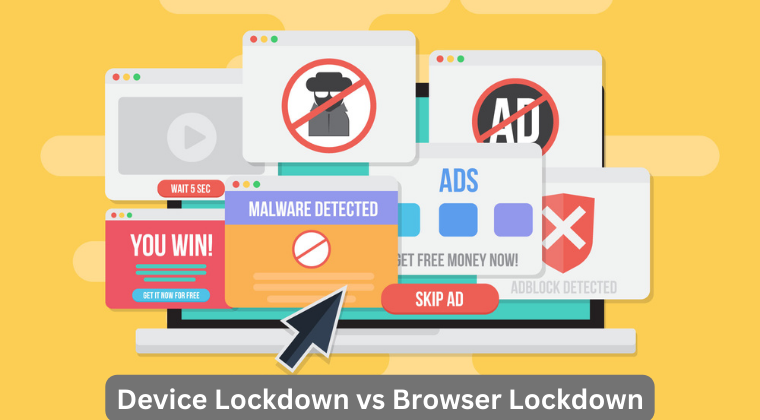Device Lockdown vs Browser Lockdown: Which Approach is Better?

Lockdown is a common term that comes to mind whenever we think of device management solutions. It is a mechanism that restricts the device to be used for a specific purpose while blocking all other functionalities and features of the digital device and only authorized staff can access those systems.
However, it is important to note that such systems are vulnerable to several cyberattacks as hackers are eager to access such protected information. Due to extreme reliance on Information Technology (IT), digital data it stores or processes is an asset for organizations as it holds sensitive customer information, credit card numbers, bank account details, trade secrets, bidding data, and tender info.
To protect this confidential information, corporates need to implement device or browser lockdown mechanisms as a security control to provide an additional layer of protection. To make the right choice for organizations, several factors need to be considered.
Device Lockdown
This mechanism implements security restrictions at Operating System (OS) level so that all unnecessary apps, peripheral controls, and functionalities of devices remain inaccessible. Device lockdown measures provide additional control, better performance, and enhanced security. This technique is more aligned towards protecting the entire device including firmware, OS, and apps installed on it.
The limited access to device functionality and apps can prevent unauthorized access, ensure conformance with internal and external regulations, and manage security. Moreover, the limited functionality of the device improves its battery life and stops it from becoming slow and bogged down.
However, this method of controlling has its own disadvantages as it reduces productivity and flexibility. Apart from this, managing policies regarding the lockdown mechanism itself is time-consuming and complex and requires lots of configurations and resources.
Browser Lockdown
It is mainly focused on improving browser security and browsing experience by limiting access to specific websites and features. It prevents users from accessing malicious websites and downloading harmful exe files.
The browser lockdown mechanisms work by installing security add-ons and other configurations whose purpose is to mitigate the security breaches associated with browsing. These add-ons stop the user from downloading malware embedded in some insecure websites and prevent them from becoming a victim of phishing.
Nonetheless, there are also some demerits associated with this approach. This technique is beneficial in situations where users must access the internet frequently as it does not deal with security issues beyond the browser.
Moreover, the limited browsing activity might lessen the benefit of web-based apps. In the same way, it reduces the productivity of users as it is quite challenging to handle exceptions related to browser lockdown.
Which Approach is Better?
It all depends on the nature, needs, level of control required, and use cases of organizations. For better security and coverage, the combination of both these approaches is recommended. But to make informed decisions, the following factors must be kept in mind.
The device lockdown mechanism is more suitable for organizations whose focus is to allow approved apps only and block other features and functionalities of devices to ensure compliance with regulatory requirements and to protect the privacy of users.
Secondly, it is appropriate for blocking access to sensitive data, trade secrets, project management tools, marketing plans, and blueprints so that the risk of information disclosure can be minimized.
Thirdly, it is useful to industries where proper concentration and focus are required as it restricts access to social networking apps and other such apps that waste the time of individuals and impact their productivity. For example, education, healthcare, and logistics are all such sectors where this approach can be effective.
A browser lockdown mechanism is more practical in research and development settings where access to external resources and websites must be blocked so that intellectual property and confidential information cannot be shared outside the organization. It is suitable for organizations that rely on web-based services to carry out their critical operations.
Moreover, industries requiring stringent controls and compliance with regulations might find this approach useful as it blocks access to non-compliant resources and websites that pose compliance or legal risks. For instance, these sectors include pharmaceutical companies, banks, and other financial institutions.
Role of Mobile Device Management Solutions
The role of Mobile Device Management (MDM) is equally important whether you choose device lockdown or browser lockdown mechanisms or a blend of these approaches. MDM provides an easy and effective way to deploy both these policies across all devices through a centralized console. With MDM solutions, organizations can ensure that their data and services remain secure and compliant with industry standards and regulations.